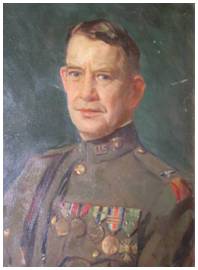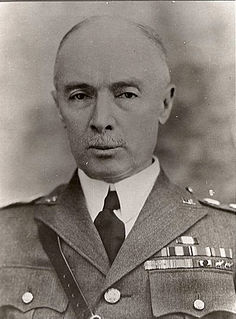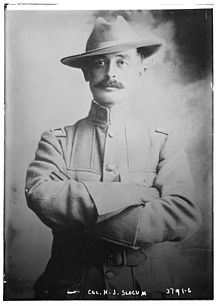Biography
Colonel Herbert J. Slocum was born on April 25, 1855 in Cincinnati, Ohio to Colonel Joseph Jermain Slocum (1833-?) and Sallie Hommedieu. He was an eighth generation descendant of Plymouth Colony militia commander Captain Myles Standish.
Slocum was appointed to the United States Military Academy on July 1, 1872, but left the academy shortly after failing to graduate in 1876. Nevertheless, he received a commission in the US Army shortly afterwards. [3] Solcum was assigned to the 7th Cavalry Regiment where he rose to the rank of captain in 1896. He spent most of his early career posted in the Dakota Territory. He graduated from the Infantry and Cavalry School in 1883.
During the Spanish–American War, Slocum was commissioned as major in the Inspector General branch in May 1898 and reverted to his permanent rank of captain a year later. He served in the occupation of Cuba from 1901 to 1902 and the Philippine Insurrection from 1905 to 1906. He was stationed in the Mid-West (mostly at Fort Riley in Kansas) from 1906 to 1910. He returned to the Philippines in 1911.
In August 1912, Slocum was promoted to colonel and assigned to Fort Leavenworth in Kansas. On September 1, 1914 he took command of the 13th Cavalry Regiment at Cavalry Camp Columbus in Columbus, New Mexico. He commanded the regiment during the Battle of Columbus on March 9, 1916, where Mexican revolutionary Pancho Villa burned several buildings in Columbus, New Mexico. Although Villa's forces were successful in capturing 300 rifles and shotguns, 80 horses, and 30 mules it came at the cost of at least 70 of his men being killed compared with American casualties of 8 soldiers and 10 civilians (including a pregnant woman) killed. Slocum was exonerated for his failure to prevent the attack by a board of inquiry led by United States Secretary of War Newton Diehl Baker, Jr. [2]
Solcum remained on active duty with the Army through World War I and retired from the Army when he reached the mandatory retirement age of 64 on April 25, 1919.
Colonel Slocum died on March 29, 1928 in Washington, DC and is buried in Arlington National Cemetery. His estate was valued at over 3 million dollars. [1] [3] [4]

Major General Hugh Lenox Scott was a United States Army officer. A West Point graduate of 1876, he served as superintendent of West Point from 1906 to 1910 and as Chief of Staff of the United States Army from 1914 to 1917, which included the first few months of American involvement in World War I.

Ernest Albert Garlington was a United States Army general who received the Medal of Honor during the Indian Wars.

Walter Scribner Schuyler was a career officer in the United States Army. A veteran of the American Indian Wars, Spanish–American War, Philippine–American War, and Mexican Border War, he attained the rank of brigadier general. A Cavalry officer, he carried out several high profile command assignments over the course of his military service, including the 5th Cavalry Regiment and Military District of Hawaii.

Major General Logan Feland was a United States Marine Corps general who last served as commanding general of the Department of the Pacific. Feland served during the Spanish–American War, the occupation of Veracruz (1914) and in World War I, where he was in command of all troops during the Battle of Belleau Wood.

Harry Dwight Chamberlin was a career officer in the United States Army. A veteran of the Moro Rebellion, Pancho Villa Expedition, World War I, and World War II, he attained the rank of brigadier general, and was most notable for his command of several Cavalry units, including 1st Squadron, 8th Cavalry Regiment, 1st Squadron, 14th Cavalry Regiment, 2nd Cavalry Regiment, the Cavalry Replacement Center at Fort Riley, and 4th Cavalry Brigade, 2nd Cavalry Division. During World War II, he commanded the New Hebrides Task Force, Southwestern Security District, and Fort Ord.

The Battle of Columbus, March 9, 1916, began as a raid conducted by Pancho Villa's Division of the North on the small United States border town of Columbus, New Mexico, located 3 miles (4.8 km) north of the border with Mexico. The raid escalated into a full-scale battle between Villistas and the United States Army.
Edward Otho Cresap Ord, II was a United States Army Major who served with the 22nd Infantry Regiment during the Indian Wars, the Spanish–American War and the Philippine–American War. He helped direct relief work after the 1906 San Francisco earthquake. He was a military instructor, an expert linguist and spent time in painting and writing poetry. He was also an inventor who patented a new type of gold pan and different types of rifle and handgun sights.
Hispanics and Latinos in the American Civil War fought on both the Union and Confederate sides of the conflict. Not all the Hispanics who fought in the American Civil War were "Hispanic-Americans", in other words citizens of the United States. Many of them were Spanish subjects or nationals from countries in the Caribbean, Central and South America. Some were born in a US Territory and therefore did not have the right to US Citizenship. It is estimated that approximately 3,500 Hispanics, mostly Mexican-Americans, Puerto Ricans and Cubans living in the United States joined the war: 2,500 for the Confederacy and 1,000 for the Union. This number increased to 10,000 by the end of the war.

Warren Webster Whitside was a career U.S. Army colonel who served as a Cavalry and Quartermaster officer. He was posthumously inducted into the Quartermaster Hall of Fame in 2010.

Brigadier General George Allan Dodd was an officer in the United States Army. He was known for his victory over the Villistas in 1916 at the Battle of Guerrero, Mexico, during the Pancho Villa Expedition.

Colonel Frank Tompkins was an officer in the United States Army. Tompkins served in numerous conflicts including the Spanish–American War in Cuba, the Philippine–American War, the Mexican Border War, and World War I. Recommended by General John J. Pershing for the Medal of Honor, he was awarded the Distinguished Service Cross for his leadership during the 1916 Battle of Columbus, New Mexico.

Benjamin Harrison Cheever Jr. was a US Army officer who received the Medal of Honor for his actions during the Indian Wars. He was born in Washington, D.C.
Frederick William Sibley, was a career United States Army officer. In addition to serving during the Indian Wars, he was Commandant of Cadets at the United States Military Academy from 1908 to 1911.

Herbert Ball Crosby was a career officer in the United States Army. A veteran of the Spanish–American War and World War I, he attained the rank of major general as the Army's Chief of Cavalry.

Julius A. Penn was a career officer in the United States Army. He attained the rank of brigadier general during World War I, and commanded 170th Infantry Brigade, 85th Division and 76th Infantry Brigade, 38th Division, in addition to serving as Chief of the Personnel Bureau for the American Expeditionary Forces.

William Lassiter was a career in the United States Army. He was a veteran of the Spanish–American War, Occupation of Veracruz, World War I, and Occupation of the Rhineland and attained the rank of major general.

Walter C. Short was a career officer in the United States Army. A veteran of the Spanish–American War, Pancho Villa Expedition, and World War I, he attained the rank of brigadier general. Short was most notable for the organization and training of several units during the first World War, and his command of the 1st Cavalry Division between World War I and World War II.

Frederick B. Shaw was a senior officer of the United States Army. A veteran of the Spanish–American War, Philippine–American War, Pancho Villa Expedition, and World War I, he attained the rank of brigadier general and is best known for commanding the 162d Depot Brigade and 36th Infantry Brigade, 18th Division.

Casper H. Conrad Jr. was a career officer in the United States Army. A veteran of the Spanish–American War, Philippine–American War, Pancho Villa Expedition, and World War I, he served from 1895 to 1936 and attained the rank of brigadier general.

John H. Hughes was a career officer in the United States Army. He attained the rank of major general, and was most notable for his command of the Philippine Division (1937–1938) and the Philippine Department (1938–1939). A veteran of the Spanish–American War, Philippine–American War, and World War I, Hughes served for 43 years beginning 1897. After retiring in 1940, he was recalled to active duty for World War II and served at the Department of War from 1941 to 1945.

















